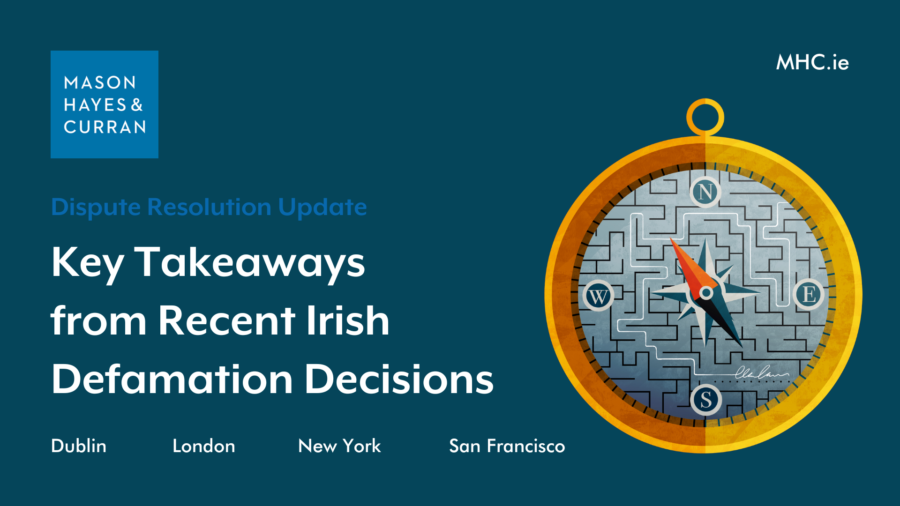Key Takeaways from Recent Irish Defamation Decisions

The beginning of 2025 has brought about a number of court decisions on defamation matters. Our Dispute Resolution team takes a look at four recent defamation decisions by the Irish Courts and provides key takeaways.
1. Jurisdiction and Forum non Conveniens
A recent defamation claim[1] related to a news story published on various platforms by CNN in October 2020. The application before the Court sought to pause the proceedings in Ireland based on the legal principle of forum non conveniens. Forum non conveniens is a concept used when another forum or court is better suited to hear a case. In this instance, Washington DC was argued to be a more appropriate forum. Unless jurisdiction is governed by Regulation (EU) No 1215/2012 (Brussels I recast), the Irish Courts have the power to pause proceedings on the grounds of forum non conveniens.
In this case, the defendants contended that all relevant events took place in the United States of America and that the proceedings should have been brought before the court of Washington DC instead of Ireland. It was argued that the Irish Courts should not handle the case because a more suitable court was available, based on the forum non conveniens principle. The plaintiffs opposed the application on a number of grounds. In particular, they argued that:
- Any claim for defamation in the USA would now be statute barred, and
- The rules regarding defamation under US law are less favourable to a plaintiff than those under Irish law
Mr Justice Simons held that the plaintiffs acted reasonably in instituting proceedings solely before the Irish Courts without also filing a protective claim in Washington DC. In particular, their claim was confined to publication within Ireland and was brought by an Irish citizen and an Irish-registered company. Therefore, the claim had a strong connection to Ireland. Mr Justice Simons also noted that the defendants were served well before the limitation period had expired in Washington DC. However, the defendant did not argue that Washington DC was the appropriate forum in time for the plaintiffs to bring proceedings there. The Court refused the application to pause the proceedings.
This case highlights the need to raise jurisdictional arguments as soon as possible in defamation proceedings. Although the outcome of the application may have ultimately been the same given the connection to Ireland, the Court clearly suggested that the plaintiff was prejudiced by the defendant’s delay in bringing its application. As a result, the plaintiff lost its opportunity to bring proceedings in the proposed alternative jurisdiction.
2. Publication must identify the Complainant
Gallagher v O'Brien Retail Concepts Limited [2025] IEHC 85
In a recent case[2], a plaintiff sought damages for defamation arising from a visit to the defendant’s off-license in April 2020. The plaintiff and her sister-in-law, Kathleen, had been selecting a bottle of wine when an employee shouted “you’re barred for shoplifting”. The plaintiff was unsuccessful in her case before the Circuit Court and the case was heard with fresh evidence before the High Court.
The defendant’s defence was narrow and was essentially an issue of identification. The defendant contended that the allegedly defamatory remarks of staff members were at all times directed towards Kathleen, and not to the plaintiff. The Court considered that what matters is simply that the ordinary bystander/reader would identify the plaintiff in the publication of the statement.
The Court found as a fact that both the plaintiff and Kathleen believed they were being accused and was of the view that the statement, when viewed objectively, did refer to the plaintiff. Mr Justice O’Higgins allowed the appeal with the issue of damages to be decided at a later date.
This decision provides further insight into the criteria for establishing a defamatory statement in Ireland and confirming the objective test as to whether a defamatory statement concerns the plaintiff. Even if the relevant employees only intended that the words spoken related to Kathleen rather than the plaintiff, the question was whether the persons present at the time identified the plaintiff.
3. Joinder of Defendant
Gilroy v O’Leary [2025] IECA 42
We previously discussed the High Court decision in Gilroy.
In summary, Google successfully argued before the High Court that the plaintiffs’ cause of action began on the date that the video was first published on YouTube. This meant that any action against Google should have been taken by 22 June 2020 at the latest.
The Court of Appeal did not take a definitive view on whether the claim was statute barred. However, it noted that a legal claim in tort does not usually arise until all necessary elements of the tort has occurred. In defamation cases, publication is one of those key elements. The Court noted that it is counterintuitive to think that a defamation claim would arise before the wrondoing actually occurs. The Court of Appeal was unwilling to dismiss the appellants’ arguments that there were two separate instances of publication:
- By the defendant in June 2018
- More than four years later, when Google either received the plaintiffs’ letter or failed to remove the content within a reasonable time
The Court of Appeal overturned the High Court’s decision. It found that if there is a valid argument that the claim against the proposed defendant is not statute barred, the Court should generally allow the defendant to be added to the case. Any debate over the limitation period should then be decided either at trial or, if suitable, as a preliminary issue.
This decision will be of some concern to internet service providers. If the appellants ultimately succeed in their arguments, it may allow complainants to delay making a complaint for many years after offending content has first been made available on a particular platform. This could, in turn, extend the period for bringing a claim well beyond the recognised statute of limitations period. Beyond creating more uncertainty about potential claims, this decision also raises a clear risk that certain relevant information or documents may no longer be available to the provider by the time a claim is made.
4. Assessment of damages
Another recent[3] decision focused on assessing the amount of damages to be awarded. This was because the Court had already ruled that the publication was defamatory after the defendant failed to respond to the claim.
The Court decided that the "assessment of damages in this case comes within level 1, the moderate category of seriousness of defamation". As a result, Mr Justice Bradley awarded the plaintiff company the sum of €40,000 in damages.
Referring to the test in Higgins [4], the Court notes that broadly speaking, general damages awards in defamation cases can be viewed within four general “categories” in the following range and one exceptional category:
Level |
Category of Seriousness |
Compensation Range (€) |
1 |
Moderate defamation |
0 – 50,000 |
2 |
Medium defamation |
50,000 – 125,000 |
3 |
Seriously defamatory material with mitigating factors such as limited publication |
125,000 – 199,000 |
4 |
Very serious defamation |
200,000 – 300,000 |
Exceptional Cases |
Very real damage to an individual’s reputation where the balance is tilted decisively in favour of vindication of good name |
Only in exceptional cases will awards be greater than 300,000 |
The First defendant accepted responsibility for four reviews posted online. Two of the reviews were removed after 24 hours, and two were removed after four days. The Court noted that the reviews were only online for a short time. However, they were nevertheless untrue. In their natural and ordinary meaning, the reviews are defamatory to the plaintiff company in the eyes of those who read the reviews online. The Court considered this case to fall within level 1, the moderate category of defamation, in terms of seriousness. As a result, it awarded damages of €40,000.
Comment
Defamation continues to be a very interesting and evolving area of law. The Defamation (Amendment) Bill 2024 was published by the Irish Government in 2024 and is currently going through the Committee Stage of the legislation enactment process. This proposed legislation provides for a range of significant reforms to Irish defamation law. These reforms are discussed further here.
While there is an ongoing increase in the number of online defamatory cases, there is also particular concern regarding the number of verbal or in-person defamation cases. The 2024 Bill proposes the introduction of a new statutory defence which will be available in ‘retail’ defamation cases such as the Gallagher case discussed above. This was a direct response to the increase in claims of verbal defamation being made against retail businesses.
For more information on successfully navigating defamation claims, contact a member of our Dispute Resolution team.
The content of this article is provided for information purposes only and does not constitute legal or other advice.
[1] Ganley & Anor v CNN & Anor [2025] IEHC 62
[2] Gallagher v O'Brien Retail Concepts Limited [2025] IEHC 85
[3] Stillorgan Gas Heating and Plumbing Limited v Manning & Anor [2025] IEHC 90
[4] Higgins v The Irish Aviation Authority [2022] IESC 13
Share this:

Gerard Kelly SC
Partner, Head of Intellectual Property Law, Co-Head of Dispute Resolution
+353 86 820 8066 gkelly@mhc.ie

